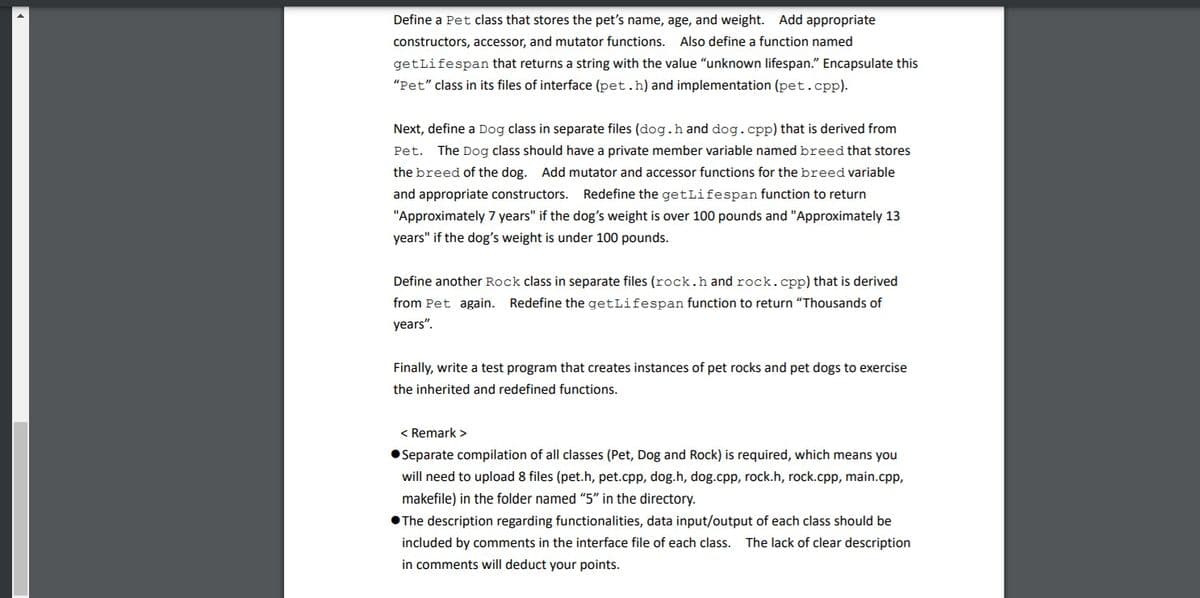Define a Pet class that stores the pet's name, age, and weight. Add appropriate constructors, accessor, and mutator functions. Also define a function named getLifespan that returns a string with the value "unknown lifespan." Encapsulate this "Pet" class in its files of interface (pet.h) and implementation (pet.cpp). Next, define a Dog class in separate files (dog.h and dog.cpp) that is derived from Pet. The Dog class should have a private member variable named breed that stores the breed of the dog. Add mutator and accessor functions for the breed variable and appropriate constructors. Redefine the getLifespan function to return "Approximately 7 years" if the dog's weight is over 100 pounds and "Approximately 13 years" if the dog's weight is under 100 pounds. Define another Rock class in separate files (rock.h and rock.cpp) that is derived from Pet again. Redefine the getLifespan function to return "Thousands of years". Finally, write a test program that creates instances of pet rocks and pet dogs to exercise the inherited and redefined functions. < Remark > Separate compilation of all classes (Pet, Dog and Rock) is required, which means you will need to upload 8 files (pet.h, pet.cpp, dog.h, dog.cpp, rock.h, rock.cpp, main.cpp, makefile) in the folder named "5" in the directory. The description regarding functionalities, data input/output of each class should be included by comments in the interface file of each class. The lack of clear description in comments will deduct your points.
Define a Pet class that stores the pet's name, age, and weight. Add appropriate constructors, accessor, and mutator functions. Also define a function named getLifespan that returns a string with the value "unknown lifespan." Encapsulate this "Pet" class in its files of interface (pet.h) and implementation (pet.cpp). Next, define a Dog class in separate files (dog.h and dog.cpp) that is derived from Pet. The Dog class should have a private member variable named breed that stores the breed of the dog. Add mutator and accessor functions for the breed variable and appropriate constructors. Redefine the getLifespan function to return "Approximately 7 years" if the dog's weight is over 100 pounds and "Approximately 13 years" if the dog's weight is under 100 pounds. Define another Rock class in separate files (rock.h and rock.cpp) that is derived from Pet again. Redefine the getLifespan function to return "Thousands of years". Finally, write a test program that creates instances of pet rocks and pet dogs to exercise the inherited and redefined functions. < Remark > Separate compilation of all classes (Pet, Dog and Rock) is required, which means you will need to upload 8 files (pet.h, pet.cpp, dog.h, dog.cpp, rock.h, rock.cpp, main.cpp, makefile) in the folder named "5" in the directory. The description regarding functionalities, data input/output of each class should be included by comments in the interface file of each class. The lack of clear description in comments will deduct your points.
C++ Programming: From Problem Analysis to Program Design
8th Edition
ISBN:9781337102087
Author:D. S. Malik
Publisher:D. S. Malik
Chapter13: Overloading And Templates
Section: Chapter Questions
Problem 20PE
Related questions
Question
Language C++

Transcribed Image Text:Define a Pet class that stores the pet's name, age, and weight. Add appropriate
constructors, accessor, and mutator functions. Also define a function named
getLifespan that returns a string with the value “unknown lifespan." Encapsulate this
"Pet" class in its files of interface (pet.h) and implementation (pet.cpp).
Next, define a Dog class in separate files (dog.h and dog.cpp) that is derived from
Pet.
The Dog class should have a private member variable named breed that stores
the breed of the dog. Add mutator and accessor functions for the breed variable
and appropriate constructors. Redefine the getLifespan function to return
"Approximately 7 years" if the dog's weight is over 100 pounds and "Approximately 13
years" if the dog's weight is under 100 pounds.
Define another Rock class in separate files (rock.h and rock.cpp) that is derived
from Pet again. Redefine the getLifespan function to return "Thousands of
years".
Finally, write a test program that creates instances of pet rocks and pet dogs to exercise
the inherited and redefined functions.
< Remark >
• Separate compilation of all classes (Pet, Dog and Rock) is required, which means you
will need to upload 8 files (pet.h, pet.cpp, dog.h, dog.cpp, rock.h, rock.cpp, main.cpp,
makefile) in the folder named "5" in the directory.
•The description regarding functionalities, data input/output of each class should be
included by comments in the interface file of each class. The lack of clear description
in comments will deduct your points.

Transcribed Image Text:Fido, age :5, weight :120, breed :Great Dane
Approximately 7 years
Pippen, age :2, weight :45, breed :Dalmatian
Approximately 13 years
Rocco, age :1000, weight :1
Thousands of years
Enter a character to exit.
Expert Solution
This question has been solved!
Explore an expertly crafted, step-by-step solution for a thorough understanding of key concepts.
This is a popular solution!
Trending now
This is a popular solution!
Step by step
Solved in 3 steps with 3 images

Knowledge Booster
Learn more about
Need a deep-dive on the concept behind this application? Look no further. Learn more about this topic, computer-science and related others by exploring similar questions and additional content below.Recommended textbooks for you

C++ Programming: From Problem Analysis to Program…
Computer Science
ISBN:
9781337102087
Author:
D. S. Malik
Publisher:
Cengage Learning

C++ Programming: From Problem Analysis to Program…
Computer Science
ISBN:
9781337102087
Author:
D. S. Malik
Publisher:
Cengage Learning